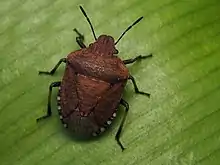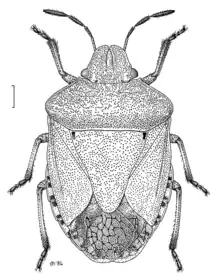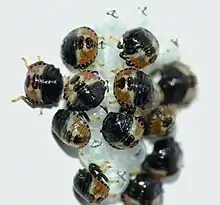| Dictyotus caenosus | |
|---|---|
 | |
| Scientific classification | |
| Kingdom: | |
| Phylum: | |
| Class: | |
| Order: | |
| Family: | |
| Genus: | Dictyotus |
| Species: | D. caenosus |
| Binomial name | |
| Dictyotus caenosus (Westwood, 1837) | |
| Synonyms | |
| |

Dictyotus caenosus, commonly known as the brown shield bug, is an Australian species of stink bug that has been introduced into New Zealand and New Caledonia.[1]
Description
Adults are between 8-10mm in length, predominantly brown, with a yellow connexivum interrupted by black bars (on the sides of the abdomen).[2] Eggs are around 0.9mm in height and diameter, pale yellowish-green when first deposited, but which subsequently take on a lemon yellow colour, and finally pink closer to hatching.[3]

Life cycle
The life cycle of Dictyotus caenosus is similar to other Pentatomidae.[4] Adults mate in spring and late summer and lay eggs in early summer. Clusters of around 18 eggs are laid on leaves or at the base of plants. Initially, eggs are a pale yellow colour, but as development progresses, the eggs eventually darken and show the eye spots and egg burster on the nymph. Nymphs all hatch from the eggs around the same time and remain near the egg mass until moulting to the second nymph stage or 'instar'. Moulting results in the nymph shedding its outer exoskeleton, which it leaves behind on its host plant. The nymphs progress through five instars before a final moult to adult. Adults are capable of flight, while nymphs are restricted to dispersing through walking. Adults are most abundant from January to March, and those surviving to the end of the season overwinter at the base of plants or under stones.[2]
Distribution
Brown shield bugs are native to Australia where they are widespread in grassy areas. They are considered adventive in New Zealand, where they are widespread and associated with wild grasses such as Plantago, and pasture crops such as lucerne.[4][5] They are also present in New Caledonia.[2]
Ecology
In New Zealand, D. caenosus is often associated with herbaceous plants and grasses in a variety of different habitats.[2] It is commonly found on roadsides, swamps, scrubland, on the edges of cultivated fields, and in paddocks. Host plants include Brassica rapa, Fragaria sp., Medicago sativa, Pisum sp., Rubus spp., Solanum aviculare, Trifolium repens, Zea mays, fodder beet, grapes, turnips, and potatoes.[2] It is sometimes found in association with native plants such as Avicennia marina subsp. australasica, Carmichaelia sp., Olearia, Coprosma rhamnoides, Cordyline australis, Dacrydium cupressinum, Festuca novae-zelandiae, Hebe salicifolia, Muehlenbeckia sp., and Myoporum laetum.[2] A number of natural enemies have been recorded using D. caenosus as a host, including the tachinid Cylindromyia bimacula (Walker) in Australia,[6] and the platygastrid egg parasitoids Trissolcus basalis (Wollaston) and T. oenone (Dodd) in New Zealand.[7]
References
- ↑ "Dictyotus caenosus: Brown shield bug". Atlas of Living Australia. Retrieved 11 July 2020.
- 1 2 3 4 5 6 Larivière, Marie-Claude (1995). Cydnidae, Acanthosomatidae, and Pentatomidae (Insecta: Heteroptera): Systematics, geographical distribution, and bioecology. Fauna of New Zealand 35. Canterbury, New Zealand: Manaaki Whenua Press. ISBN 0-478-09301-2.
- ↑ Myers, J. G. (1926). "Biological notes on New Zealand Heteroptera". Transactions and Proceedings of the New Zealand Institute. 56: 449–511.
- 1 2 Martin, Nicholas. "Brown shield bug - Dictyotus caenosus". New Zealand Arthropod Factsheet Series.
- ↑ "Dictyotus caenosus (Brown shield bug)". Manaaki Whenua Landcare Research.
- ↑ Coombs, M.; Kahn, S. A. (1997). "New host / parasitoid records for Australian Pentatomidae, Tachinidae and Braconidae". The Australian Entomologist. 24 (2): 61–64.
- ↑ Cumber, Ron. A. (1964). "The egg-parasite complex (Scelionidae: Hymenoptera) of shield bugs (Pentatomidae, Acanthosomidae: Heteroptera) in New Zealand". New Zealand Journal of Science. 7 (4): 536–554.